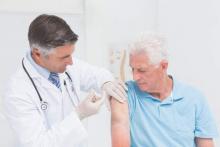Vaccine coverage of adults in the United States continues to be low for the seven vaccines currently recommended by the Centers for Disease Control and Prevention, according to a study published in MMWR.
Illness attributable to vaccine-preventable diseases is more prevalent among adults than among children, and is especially high among the oldest adults.
For example, an estimated 50%-70% of influenza-related hospitalizations, 80%-90% of influenza-related deaths, and 50% of invasive pneumococcal disease each year occur in people aged 65 years and older, noted Dr. Walter W. Williams of the National Center for Immunization and Respiratory Diseases, CDC, Atlanta, and his associates.
The influenza vaccine is recommended for all adults every year; the Td (pneumococcal, tetanus, diphtheria), Tdap (tetanus, diphtheria, acellular pertussis), hepatitis A, hepatitis B, herpes zoster, and HPV (human papillomavirus) vaccines are routinely recommended for many adults based on patient age, underlying medical conditions, lifestyle factors, occupation, travel, and other considerations.
However, adult vaccination coverage is low because of limited public awareness about the need for these vaccines, lack of vaccine requirements for adults like the immunization requirements in place for children, failure to incorporate routine vaccine assessments and recommendations in adult health care visits, the costs of stocking vaccines and providing vaccine services, inadequate or inconsistent payment for vaccines and for vaccine administration, and the tendency to prioritize acute over preventive medical care, they noted.
The investigators assessed nationwide vaccine coverage of adults using data from the 2013 and 2014 National Health Interview Survey, which annually collects health information from a large, nationally representative sample of households via in-person interviews. The 2014 sample included 36,324 adults who self-reported their vaccination status (Morb Mortal Wkly Rep Surveill Summ. 2016;65:1-36).
Coverage for Tdap slightly increased 2.9 percentage points to 20.1% of the eligible population in 2014, the most recent year for which data are available, and coverage for herpes zoster among high-risk patients aged 60 and older slightly increased 3.6 percentage points to 27.9% of the population. Coverage for the other five vaccines remained steady and low: for the influenza vaccine, 43.2% of the population; for the pneumococcal vaccine, 20.3% of high-risk younger adults and 61.3% of very high-risk older adults; for the Td vaccine, 62.2%; for hepatitis A, 9%; for hepatitis B, 24.5%; and for HPV, coverage was 8.2% for men and 40.2% for women aged 19-26 years.
As expected, vaccine coverage was lower for people who didn’t have health insurance, didn’t have a usual site for receiving health care, and didn’t have any physician contacts during the preceding year. However, even among adults who had health insurance and had 10 or more physician contacts within the past year, up to 88% reported that they hadn’t received vaccinations that were recommended for everyone or for specific populations.
Racial and ethnic gaps in vaccine coverage persisted for five of these vaccines and actually worsened for the Tdap and herpes zoster vaccines.
Advice from health care providers is strongly associated with delivery of adult vaccinations. To address these gaps in vaccine coverage, clinicians should consider routine assessment of all adult patients’ vaccine needs, use of a reminder/recall system, use of standing-order programs for vaccination, and assessment of their practices’ vaccination rates. “Efforts are also needed to identify adults who do not have a regular provider or insurance and who report fewer health care visits,” Dr. Williams and his associates said.
The CDC updates vaccine recommendations annually and publishes them in the U.S. Adult Immunization Schedule, which is “a ready resource for persons who provide healthcare services in various settings,” they added.
The CDC supported the study. The authors’ financial disclosures were not provided.


